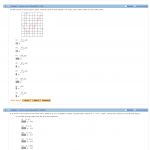Click on the images to open a new tab and see them in full resolution.
1. If a ball is thrown in the air with a velocity 46 ft/s, its height in feet t seconds later is given by y = 46t -16t^2.
a. Find the average velocity for the time period beginning when t = 2 and lasting
(i) 0.5 second. Answer: -26
(ii) 0.1 second. Answer: -19.6
(iii) 0.05 second. Answer: -18.8
(iv) 0.01 second. Answer: -18.16
b. Estimate the instantaneous velocity when t = 2.
Answer: -18
If a ball is thrown in the air with a velocity 48 ft/s, its height in feet t seconds later is given by y = 48t -16t^2.
c. Find the average velocity for the time period beginning when t = 2 and lasting
(v) 0.5 second. Answer: -24
(vi) 0.1 second. Answer: -17.6
(vii) 0.05 second. Answer: -16.8
(viii) 0.01 second. Answer: -16.16
d. Estimate the instantaneous velocity when t = 2.
Answer: -16
If a ball is thrown in the air with a velocity 50 ft/s, its height in feet t seconds later is given by y = 50t -16t^2.
e. Find the average velocity for the time period beginning when t = 2 and lasting
(ix) 0.5 second. Answer: -22
(x) 0.1 second. Answer: -15.6
(xi) 0.05 second. Answer: -14.8
(xii) 0.01 second. Answer: -14.16
f. Estimate the instantaneous velocity when t = 2.
Answer: -14
Use the given graph of f to state the value of each quantity, if it exists. (If an answer does not exist, enter DNE.)
2. (a) Answer: 3
(b) Answer: 1
(c) Answer: DNE
(e) Answer: 4
(f) Answer: DNE
For the function g whose graph is given, state the value of each quantity, if it exists. (If an answer does not exist, enter DNE.)
3. (a) Answer: -1
(b) Answer: -2
(c) Answer: DNE
(e) Answer: 2
(f) Answer: DNE
(g) Answer: 1
(h) Answer: 3
4. If an arrow is shot upward on the moon with a speed of 64m/s its height in meters t seconds later is given by y = 64t – 0.83t^2 (Round your answer to two decimal places.)
(a) Find the average speed over the given time intervals.
(i) Answer: 61.51
(ii) Answer: 61.93
(iii) Answer: 62.26
(iv) Answer: 62.33
(v) Answer: 62.34
(b) Estimate the speed when t = 1
Answer: 62.34
If an arrow is shot upward on the moon with a speed of 68m/s its height in meters t seconds later is given by y = 68t – 0.83t^2 (Round your answer to two decimal places.)
(c) Find the average speed over the given time intervals.
(vi) Answer: 65.51
(vii) Answer: 65.93
(viii) Answer: 66.26
(ix) Answer: 66.33
(x) Answer: 66.34
(d) Estimate the speed when t = 1
Answer: 66.34
5. Evaluate the function f(x) at the given numbers(correct to six decimal places).
f(x) = (x^2-3x)/(x^2-2x-3), x = 0,-0.5,-0.9,-0.95,-0.99,-0.999,-2,-1.5,-1.01,-1.001
f(0) = 0
f(-0.5) = -1
f(-0.9) = -9
f(-0.95) = -19
f(-0.99) = -99
f(-0.999) = -999
f(-2) = 2
f(-1.5) = 3
f(-1.1) = 11
f(-1.01) =101
f(-1.001) = 1001
Guess the value of the limit of f(x) as x approaches -1, correct to six decimal places. (If an answer does not exist, enter DNE.)
lim x approaches -1 [(x^2-3x)/(x^2-2x-3)] = DNE
**All answers are the same for this problem even with different red numbers. **
6. Use a table of values to estimate the value of the limit. If you have a graphing device use is to confirm your results graphically. (Round your answer to two decimal places.)
Lim x approaches 0 ((sqrt(x+49)-7))/x
Answer: 0.07
Use a table of values to estimate the value of the limit. If you have a graphing device use is to confirm your results graphically. (Round your answer to two decimal places.)
Lim x approaches 0 ((sqrt(x+64)-8))/x
Answer: 0.06
7. Use a table of values to estimate the value of the limits. If you have a graphing device, use it to confirm your results graphically. (Round your answer to two decimal places.)
lim x approaches 1 (x^7-1)/(x^5-1)
Answer: 1.40
Use a table of values to estimate the value of the limits. If you have a graphing device, use it to confirm your results graphically. (Round your answer to two decimal places.)
lim x approaches 1 (x^9-1)/(x^5-1)
Answer: 1.8
Use a table of values to estimate the value of the limits. If you have a graphing device, use it to confirm your results graphically. (Round your answer to two decimal places.)
lim x approaches 1 (x^8-1)/(x^4-1)
Answer: 2









